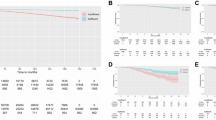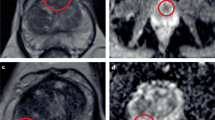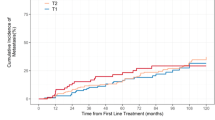Abstract
Prostate cancer stage migration has changed the diagnostic approach toward men at risk of the disease. For example, sextant needle biopsy of the prostate has been abandoned in favor of biopsies using 10 or more cores. This has in turn affected the stage and grade of newly diagnosed prostate cancers, with a shift toward earlier stage and lower grade. In this manuscript we review novel diagnostic, staging, and preoperative prognostic nomograms that have been developed to accommodate the stage migration. Several novel nomograms have been developed for the purpose of prediction of initial and repeat-biopsy outcomes using 10 or more biopsy cores. Additionally, a novel saturation biopsy nomogram has also been devised. For the purpose of staging, the Partin tables have recently been updated. A series of contemporary nomograms have also been developed to predict extracapsular extension, seminal vesicle invasion, and lymph node invasion. The preoperative nomogram for prediction of biochemical recurrence, introduced by Kattan and colleagues, has been updated and predicts up to 10 years after radical prostatectomy.
Key Points
-
Prediction of prostate cancer at initial and repeat biopsy is best achieved with nomograms based on 10 or more biopsy cores
-
Due to differences in serum PSA level, clinical stage, and biopsy Gleason sum distribution between North American and European men, continent-specific tools should be considered
-
Extracapsular extension, seminal vesicle invasion, and lymph node invasion can be predicted in the most contemporary and highly accurate fashion with the novel European staging nomograms that predominantly rely on diagnoses made with 10 or more core biopsies
-
Currently, biochemical recurrence rates after alternative treatment modalities can be compared with brachytherapy, external beam radiotherapy, and radical prostatectomy nomograms
This is a preview of subscription content, access via your institution
Access options
Subscribe to this journal
Receive 12 print issues and online access
$209.00 per year
only $17.42 per issue
Buy this article
- Purchase on Springer Link
- Instant access to full article PDF
Prices may be subject to local taxes which are calculated during checkout





Similar content being viewed by others
References
Jemal A et al. (2007) Cancer statistics, 2007. CA Cancer J Clin 57: 43–66
Steuber T et al. (2006) Validation of a nomogram for prediction of side specific extracapsular extension at radical prostatectomy. J Urol 175: 939–944
Irish WD et al. (2003) Nomogram for predicting the likelihood of delayed graft function in adult cadaveric renal transplant recipients. J Am Soc Nephrol 14: 2967–2974
Eastham JA et al. (1999) Development of a nomogram that predicts the probability of a positive prostate biopsy in men with an abnormal digital rectal examination and a prostate-specific antigen between 0 and 4 ng/ml. Urology 54: 709–713
Karakiewicz PI et al. (2005) Development and validation of a nomogram predicting the outcome of prostate biopsy based on patient age, digital rectal examination and serum prostate specific antigen. J Urol 173: 1930–1934
Yanke BV et al. (2006) African-American race is a predictor of prostate cancer detection: incorporation into a pre-biopsy nomogram. BJU Int 98: 783–787
Chun FK et al. (2007) Development and external validation of an extended 10-core biopsy nomogram. Eur Urol 52: 436–445
O'Dowd GJ et al. (2000) Analysis of repeated biopsy results within 1 year after a noncancer diagnosis. Urology 55: 553–559
Lopez-Corona E et al. (2003) A nomogram for predicting a positive repeat prostate biopsy in patients with a previous negative biopsy session. J Urol 170: 1184–1188
Yanke BV et al. (2005) Validation of a nomogram for predicting positive repeat biopsy for prostate cancer. J Urol 173: 421–424
Chun FK et al. (2007) Development and external validation of an extended repeat biopsy nomogram. J Urol 177: 510–515
Patel AR et al. (2004) Parasagittal biopsies add minimal information in repeat saturation prostate biopsy. Urology 63: 87–89
Rabets JC et al. (2004) Prostate cancer detection with office based saturation biopsy in a repeat biopsy population. J Urol 172: 94–97
Stewart CS et al. (2001) Prostate cancer diagnosis using a saturation needle biopsy technique after previous negative sextant biopsies. J Urol 166: 86–91
Borboroglu PG et al. (2000) Extensive repeat transrectal ultrasound guided prostate biopsy in patients with previous benign sextant biopsies. J Urol 163: 158–162
Walz J et al. (2006) High incidence of prostate cancer detected by saturation biopsy after previous negative biopsy series. Eur Urol 50: 498–505
Fleshner N et al. (2002) Role of “saturation biopsy” in the detection of prostate cancer among difficult diagnostic cases. Urology 60: 93–97
Partin AW et al. (1997) Combination of prostate-specific antigen, clinical stage, and Gleason score to predict pathological stage of localized prostate cancer. A multi-institutional update. JAMA 277: 1445–1451
Partin AW et al. (2001) Contemporary update of prostate cancer staging nomograms (Partin tables) for the new millennium. Urology 58: 843–848
Makarov DV et al. (2007) Updated nomogram to predict pathologic stage of prostate cancer given prostate-specific antigen level, clinical stage, and biopsy Gleason score (Partin tables) based on cases from 2000 to 2005. Urology 69: 1095–1101
Graefen M et al. (2001) A validated strategy for side specific prediction of organ confined prostate cancer: a tool to select for nerve sparing radical prostatectomy. J Urol 165: 857–863
Ohori M et al. (2004) Predicting the presence and side of extracapsular extension: a nomogram for staging prostate cancer. J Urol 171: 1844–1849
Koh H et al. (2003) A nomogram to predict seminal vesicle invasion by the extent and location of cancer in systematic biopsy results. J Urol 170: 1203–1208
Gallina A et al. (2007) Development and split-sample validation of a nomogram predicting the probability of seminal vesicle invasion at radical prostatectomy. Eur Urol 52: 98–105
Hutterer GC et al. (2007) The evolution of staging of lymph node metastases in clinically localized prostate cancer. EAU-EBU Update Series 5: 153–162
Cagiannos I et al. (2003) A preoperative nomogram identifying decreased risk of positive pelvic lymph nodes in patients with prostate cancer. J Urol 170: 1798–1803
Briganti A et al. (2007) Critical assessment of ideal nodal yield at pelvic lymphadenectomy to accurately diagnose prostate cancer nodal metastasis in patients undergoing radical retropubic prostatectomy. Urology 69: 147–151
Briganti A et al. (2006) Validation of a nomogram predicting the probability of lymph node invasion based on the extent of pelvic lymphadenectomy in patients with clinically localized prostate cancer. BJU Int 98: 788–793
DiMarco DS et al. (2005) The extent of lymphadenectomy for pTXNO prostate cancer does not affect prostate cancer outcome in the prostate specific antigen era. J Urol 173: 1121–1125
Briganti A et al. (2006) Validation of a nomogram predicting the probability of lymph node invasion among patients undergoing radical prostatectomy and an extended pelvic lymphadenectomy. Eur Urol 49: 1019–1026
Briganti A et al. (2007) A nomogram for staging of exclusive nonobturator lymph node metastases in men with localized prostate cancer. Eur Urol 51: 112–119
Chun FK et al. (2006) Significant upgrading affects a third of men diagnosed with prostate cancer: predictive nomogram and internal validation. BJU Int 98: 329–334
Chun FK et al. (2006) Development and internal validation of a nomogram predicting the probability of prostate cancer Gleason sum upgrading between biopsy and radical prostatectomy pathology. Eur Urol 49: 820–826
Epstein JI et al. (1998) Nonpalpable stage T1c prostate cancer: prediction of insignificant disease using free/total prostate specific antigen levels and needle biopsy findings. J Urol 160: 2407–2411
Kattan MW et al. (2003) Counseling men with prostate cancer: a nomogram for predicting the presence of small, moderately differentiated, confined tumors. J Urol 170: 1792–1797
Steyerberg EW et al. (2007) Prediction of indolent prostate cancer: validation and updating of a prognostic nomogram. J Urol 177: 107–112
Klotz L (2005) Active surveillance for prostate cancer: for whom? J Clin Oncol 23: 8165–8169
Kattan MW et al. (1998) A preoperative nomogram for disease recurrence following radical prostatectomy for prostate cancer. J Natl Cancer Inst 90: 766–771
Kattan MW et al. (2000) Pretreatment nomogram for predicting the outcome of three-dimensional conformal radiotherapy in prostate cancer. J Clin Oncol 18: 3352–3359
Kattan MW et al. (2001) Pretreatment nomogram for predicting freedom from recurrence after permanent prostate brachytherapy in prostate cancer. Urology 58: 393–399
[No authors listed] (1997) Consensus statement: guidelines for PSA following radiation therapy. American Society for Radiology and Oncology Consensus Panel. Int J Radiat Oncol Biol Phys 37: 1035–1041
Graefen M et al. (2002) International validation of a preoperative nomogram for prostate cancer recurrence after radical prostatectomy. J Clin Oncol 20: 3206–3212
Specht MC et al. (2005) Predicting nonsentinel node status after positive sentinel lymph biopsy for breast cancer: clinicians versus nomogram. Ann Surg Oncol 12: 654–659
Stephenson AJ et al. (2006) Preoperative nomogram predicting the 10-year probability of prostate cancer recurrence after radical prostatectomy. J Natl Cancer Inst 98: 715–717
Acknowledgements
PI Karakiewicz is partially supported by the University of Montreal Heath Center Urology Associates, Fonds de la Recherche en Santé du Québec, the University of Montreal Department of Surgery, and the University of Montreal Health Center (CHUM) Foundation.
Author information
Authors and Affiliations
Corresponding author
Ethics declarations
Competing interests
The authors declare no competing financial interests.
Rights and permissions
About this article
Cite this article
Karakiewicz, P., Hutterer, G. Predictive models and prostate cancer. Nat Rev Urol 5, 82–92 (2008). https://doi.org/10.1038/ncpuro0972
Received:
Accepted:
Issue Date:
DOI: https://doi.org/10.1038/ncpuro0972
This article is cited by
-
Metabolomic Prediction of Human Prostate Cancer Aggressiveness: Magnetic Resonance Spectroscopy of Histologically Benign Tissue
Scientific Reports (2018)
-
Identification of genes regulating migration and invasion using a new model of metastatic prostate cancer
BMC Cancer (2014)
-
Regulation of epithelial plasticity by miR-424 and miR-200 in a new prostate cancer metastasis model
Scientific Reports (2013)
-
Laparoscopic radical prostatectomy plus extended lymph nodes dissection for cases with non-extra node metastatic prostate cancer: 5-year experience in a single Chinese institution
Journal of Cancer Research and Clinical Oncology (2013)
-
Prediction of pathological and oncological outcomes based on extended prostate biopsy results in patients with prostate cancer receiving radical prostatectomy: a single institution study
Diagnostic Pathology (2012)



